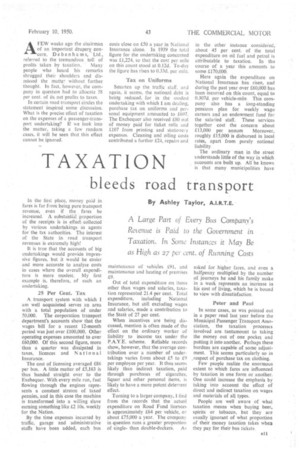TAXATION
Page 45

If you've noticed an error in this article please click here to report it so we can fix it.
bleeds road transport
By Ashley Taylor, A.I.R.T.E.
A Large Part of Every Bus Company's Revenue is Paid to the Government in Taxation. In Some Instances it May Beas High as 27 per cent. of Running Costs
In the first place, money paid in fares is far from being pure transport revenue, even if the fares be increased. A substantial proportion of the receipts is in effect collected by various undertakings as agents for the tax authorities. The interest of the State inroad transport revenues is extremely high!
It is true that the accounts of big undertakings would provide impressive figures, but it would be easier and more accurate to analyse costs in cases where the overall expenditure is more modest. My first example is, therefore, of such an undertaking.
25 Per Cent. Tax
A transport system with which I am well acquainted serves an area with a total population of under 50,000. The corporation transport department's accounts show that the wages bill for a recent 12-month period was just over £100,000. Other operating expenses amounted to over £60,000. Of this second figure, more than a quarter was dissipated in taxes, licences and National Insurance.
The cost of licensing averaged £86 per bus. A little matter of £5,163 is thus handed straight over to the Exchequer. With every mile run, fuel flowing through the engines represents a constant stream of taxed pennies, and in this case the machine is transformed into a willing slave earning something like £2 10s. weekly for the Nation.
By the time expenses incurred by traffic, garage and administrative staffs have been added, each bus maintenance of vehicles 191, and maintenance and heating of premises £9.
Out of total expenditure on items other than wages and salaries, taxation represented 21.4 per cent. Total expenditure, including National Insurance, but still excluding wages and salaries, made a contribution to the State of 27 per cent.
When incentives are being discussed, mention is often made of the effect on the ordinary worker of liability to income tax under the P.A.Y.E. scheme. Reliable records show, however, that the average contribution over a number of undertakings varies from about £5 to £9 per employee per year. It thus seems likely than indirect taxation, paid through purchases of cigarettes, liquor and other personal items, is likely to have a more potent deterrent effect.
Turning to a larger company, I find from the records that the actual expenditure on Road Fund licences is approximately £64 per vehicle, or about £75,000 a year. The company in question runs a greater proportion of singlethan double-deckers. As asked for higher fares, and even a halfpenny multiplied by the number of journeys he and his family make in a week represents an increase in his cost of living, which he is bound to view with dissatisfaction.
Peter and Paul
In some cases, as was pointed out in a paper read last year before the Municipal Passenger Transport Association, the taxation processes involved are tantamount to taking the money out of one pocket and putting it into another. Perhaps these burdens are capable of some adjustment. This seems particularly so in ,respect of purchase tax on clothing.
Few people realize the enormous extent to which fares are influenced by taxation in one form or another. One could increase the emphasis by taking into account the effect of direct and indirect taxation on wages and materials of all types.
People are well aware of what taxation means when buying beer, spirits or tobacco, but they are usually ignorant of what proportion of their money taxation takes when they pay for their bus tickets




















































































